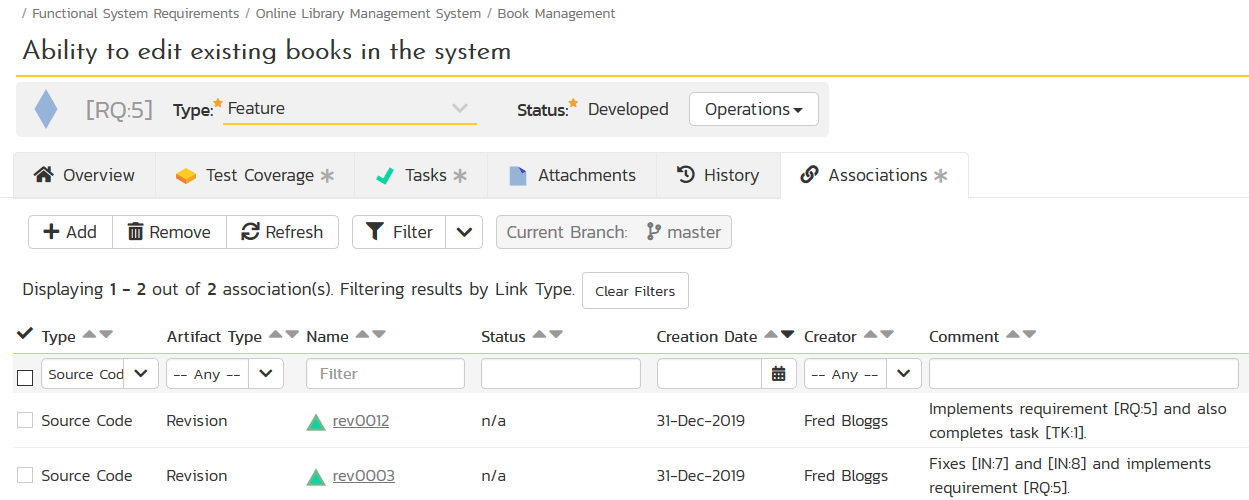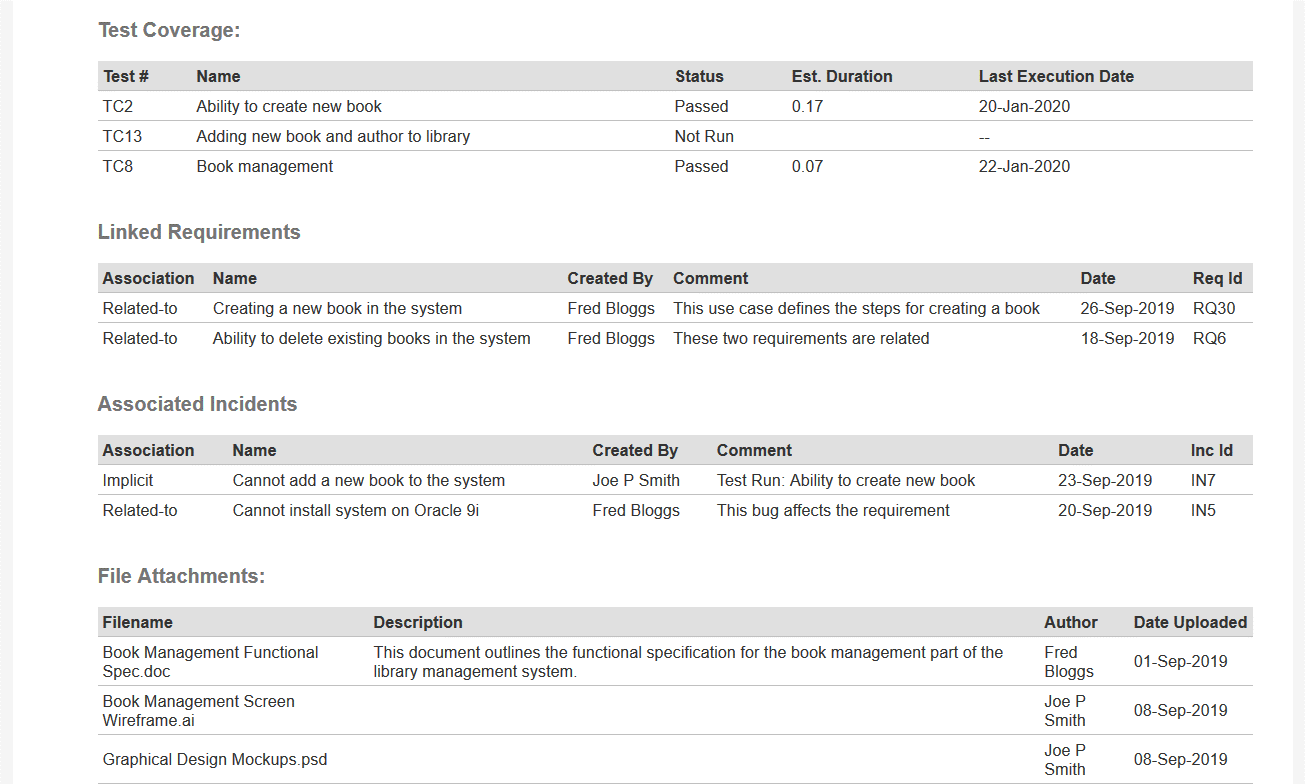Requirements Traceability
The success of software projects heavily relies on a strong foundation — requirements are a cornerstone of creating this.
What is Requirements Traceability?
Requirements traceability refers to the ability to tie high-level project objectives and deliverables to specific documented requirements, following the life of a requirement in both forward and backward directions. This means from its origins, through its development and specification, to its subsequent deployment and use, and through all periods of ongoing refinement and iteration in any of these phases.
Benefits of Strong Requirements Traceability
Requirements traceability analysis is an important part of the software engineering process because it ensures that all requirements have been adequately considered. This not only considers each phase of the project, but also confirms that there aren't any scope “holes” in the developed system due to missed requirements. Beyond this, the beneficial outcomes and impacts of requirements traceability include:
- More Effective Risk Management: Linking requirements to their origins and tracking their evolution through the development process helps teams identify potential issues early. This approach allows for quick adjustments, preventing problems from escalating. Anticipating and reducing risks before they become critical helps the project stay on a stable course, minimizing disruptions and costly reworks.
- Improved Requirement Validation: Traceability also verifies that all requirements have been addressed and met. Its structured approach is useful for confirming that the final product aligns with the initial specifications and stakeholder needs. Without traceability, it’s increasingly difficult to ensure comprehensive requirement coverage — especially in large-scale projects with numerous interdependencies.
- Better Defect Management: When bugs inevitably arise, traceability is handy for pinpointing the root cause (by tracing back to the linked requirements). This streamlines the identification and resolution of issues, as well as the implementation of necessary changes or updates. The result is more efficient defect management, which saves time and resources.
- Keep Projects on Schedule/Budget: By keeping a clear trail of requirements, teams can avoid redundant efforts and duplication of work. In other words, unnecessary research, analysis, and reworks are drastically reduced, which keeps projects on track and on budget.
- Enhanced Overall Project Quality: Ultimately, traceability creates a foundational understanding of requirements and their relationships throughout the project lifecycle. This structured framework for tracking and managing requirements makes sure that all aspects of the project align with the original goals. The resulting quality assurance boosts stakeholder and user satisfaction, leading to project success.
Requirements Traceability Matrix
The most common way of ensuring that there is full traceability of requirements is by using a Requirements Traceability Matrix (RTM). The traceability matrix is used to verify that all stated and derived requirements are associated with corresponding design elements, system components, modules, and other project deliverables — known as forward traceability. The RTM is also used to verify and document the original source of the requirements so questions from the customer about why certain features were included have a comprehensive audit trail — this is known as backward traceability (more on each of these later).
The requirements traceability matrix itself can be created using simple tools like a spreadsheet or even pen and paper. However, an integrated requirements management tool is usually the best choice to avoid needing to maintain lots of separate artifacts.
These systems allow you to manage the list of requirements and associate the other project artifacts (test cases, use cases, tasks, defects, source code revisions, presentations, interview notes, etc.) with them in a collaborative environment. When you can link all of these items together in both directions, you have end-to-end traceability.
Types of Traceability in a RTM
As mentioned above, there are two primary directions for traceability: Forward and Backward. Let’s explore each in more detail:
Forward Traceability
This refers to documenting the associations between the functional and system requirements and the various artifacts created during the design, development, and testing of the system. Some example artifacts that can be found at each phase include:
Requirements Phase
Business and system use cases need to be validated against the functional and system requirements, to ensure complete coverage.
Design Phase
Design elements, object models, data models, module designs, sequence diagrams, user interface designs, and other design artifacts need to be related back to the system requirements.
Development Phase
Unit tests and changes to the source code (e.g. commits made to the Software Configuration Management tool) should be linked to the requirements that they satisfy. Similarly, the project development tasks should be associated with the source requirement that they fulfill.
Testing Phase
Maintenance Phase
All defects and system issues that are raised need to be associated with the module and source requirement. This is so that structural weaknesses in the system can be fixed or adjusted holistically during the next release cycle.
Forward Requirements Traceability Matrix Example
A forward requirements traceability matrix for our fictitious Library Information System might include:
|
ID |
System Requirement |
Use Cases |
Design Elements |
Test Cases |
|
RQ1 |
Ability to create a new book in catalog |
UC1, UC4, UC5 |
DE3, DE6 |
TC1, TC6, TC9 |
|
RQ2 |
Ability to edit existing book in catalog |
UC1, UC2 |
DE4 |
TC3, TC8 |
|
RQ3 |
Ability to create a new author in catalog |
UC1, UC8, UC9 |
DE22 |
TC1, TC9 |
Backward / Reverse Traceability
This refers to the need to document the lineage and source of all the requirements defined in the Software Requirements Specification (SRS). As described in our article about Requirements Gathering, these can come from many different sources (written list from the customer representative, interviews with stakeholders, discussions with developers, workshop deliverables, focus groups of end-users, etc.).
Backward Requirements Traceability Matrix Examples
These different stakeholders will have different views of the requirements, so it’s a good idea to create a requirements traceability matrix to trace each developed feature back to the person, group, or entity that requested it during the requirements gathering:
|
ID |
System Requirement |
Source Documents |
Stakeholders |
Elictation Activity |
|
RQ1 |
Ability to create a new book in catalog |
Project Goals List 1.22.2000 |
Chief Librarian |
Goals Development Workshop |
|
RQ2 |
Ability to edit existing book in catalog |
None - implied |
Librarian Joe Smith |
Requirements analysis meeting 1.30.2000 |
|
RQ3 |
Ability to create a new author in catalog |
Project Goals List 1.22.2000 |
Chief Librarian |
Goals Development Workshop |
Another form of backward traceability is used to illustrate the relationship between the various artifacts developed during the project and the source requirements that they support. In this case, it is basically the same data as the example matrix for forward traceability illustrated in the previous section, just switched to the perspective of the downstream deliverables. Whereas the forward RTM made sure that all requirements were covered, the reverse RTM would make sure that unnecessary design elements, use cases, test cases, etc. were not being worked on:
|
ID |
Use Case |
System Requirement |
Design Elements |
Test Cases |
|
UC1 |
Adding new book to library catalog |
RQ1, RQ2, RQ3 |
DE3, DE6 |
TC1 |
|
UC2 |
Updating the details of a book in the system |
RQ2 |
DE4 |
TC3 |
|
UC3 |
Deleting a book in the system |
RQ5 |
DE22, DE4 |
TC7 |
RTM Report Types (with Examples)
There are several different levels of requirements traceability reports. The simplest form looks like the tables above and provides a summary list of the relationships between the artifacts:
However, sometimes a more detailed requirements document is needed that includes details of all the associated downstream artifacts:
This is why it is wise to verify upfront what level of detail is required when you’re asked to create an RTM for a project.
Requirements Traceability Best Practices
When it comes to implementation, there’s much more to success than just creating a matrix. Here are some additional best practices to keep in mind:
- Starting with clear and concise requirements reduces potential confusion and misinterpretation, which could otherwise derail the project. Checking that each requirement is well-defined and easily understandable creates a solid foundation and clarity that ensures everyone is on the same page for project goals, reducing the risk of errors and omissions.
- Continuous traceability should be maintained throughout the project lifecycle by regularly updating the traceability matrix and related documents to reflect any changes in requirements, design, or implementation. This keeps the traceability data up-to-date to serve as a reliable basis for decision-making. By keeping traceability continuous, teams can quickly adapt to changes, manage risks more effectively, and maintain alignment with project objectives — enhancing overall project agility.
- Engaging stakeholders throughout the requirements traceability process is another ongoing essential for success. Stakeholders provide valuable insights and feedback that could help shape the requirements and their traceability. Frequent communication and collaboration make sure that their needs and expectations are accurately captured and reflected in the traceability framework.
- Providing training and support to team members on requirements traceability practices is critical for successful adoption and implementation. It helps team members understand the importance of traceability, how to use the tools effectively, and how to integrate traceability into their daily tasks. Beyond initial training, ongoing support addresses any future questions or issues, fostering continuous improvement.
- Facilitating bidirectional traceability enables navigation both forward (from requirements to implementation artifacts) and backward (from implementation to source requirements). This bidirectionality enhances impact analysis, change management, and overall traceability effectiveness.
- Automating processes using requirements management software significantly boosts the efficiency and accuracy of requirements traceability. Many modern tools offer features to streamline documentation with standardized templates and automate other aspects of traceability (including generating traceability matrices, establishing links between artifacts, and propagating changes across linked items). By reducing manual effort, automation saves time, cuts costs, and scales with project complexity, ensuring effective traceability management throughout the project lifecycle.
The Best Requirements Traceability Software Available
Speaking of requirements management tools, SpiraTeam does it all — manages your project's requirements, use cases, tests, tasks, source code, and issues in one integrated environment, with full traceability throughout the product development lifecycle.
- It’s a comprehensive requirements management solution that provides multiple views of requirements, including a document, hierarchy, grid, mind map, and Kanban board.
- Writing requirements is only the start, which is why SpiraTeam helps plan your team’s work with its integrated project, product, and quality management system.
- SpiraTeam enables you to connect your requirements to your other product artifacts for end-to-end traceability — you can link requirements to your test cases, issues, tasks, defects and builds, and source code.
How do I Get Started?
To learn more about SpiraTeam and how it can be used to improve your management of requirements traceability:












